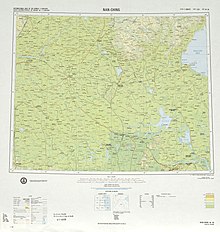T'ai-chou
Appearance
English
[edit]Etymology 1
[edit]From Mandarin 台州 Wade–Giles romanization: Tʻai¹-chou¹.
Proper noun
[edit]T'ai-chou
- Alternative form of Taizhou, Zhejiang.
- 1962, F. W. Mote, “Fang Kuo-chen”, in The Poet Kao Chʻi[2], Princeton, N.J.: Princeton University Press, →LCCN, →OCLC, page 19:
- He was a native of Tʻai-chou (modern Lin-hai) on the central Chekiang coast, from a family that engaged in sea transport of salt.
- For more quotations using this term, see Citations:T'ai-chou.
Translations
[edit]Taizhou — see Taizhou
Etymology 2
[edit]
From Mandarin 泰州 (Tàizhōu) Wade-Giles romanization: Tʻai⁴-chou¹.[1]
Proper noun
[edit]T'ai-chou
- Alternative form of Taizhou, Jiangsu.
- 1962, Carsun Chang, The Development of Neo-Confucian Thought[3], volume 2, Bookman Associates, →LCCN, →OCLC, page 114:
- At this time Wang Shou-ken, while governor of Kiangsi province, was discussing philosophical problems related to his theory of liang-chih. He already had many followers south of the Yangtze, but Wang Ken in far off T'ai-chou knew nothing about this.
- 1967, Holmes Welch, The Practice of Chinese Buddhism 1900-1950[4], Cambridge, Mass.: Harvard University Press, published 1973, →ISBN, →LCCN, →OCLC, page 223:
- About 700 tan of barley were collected and sold in Tʻai-chou, while 450 tan of wheat were dispatched to the monastery from I-cheng and elsewhere.
- For more quotations using this term, see Citations:T'ai-chou.
Translations
[edit]Taizhou — see Taizhou
References
[edit]- ^ Taizhou, Wade-Giles romanization T’ai-chou, in Encyclopædia Britannica
Further reading
[edit]- “T’ai-chou”, in Merriam-Webster Online Dictionary, Springfield, Mass.: Merriam-Webster, 1996–present.
